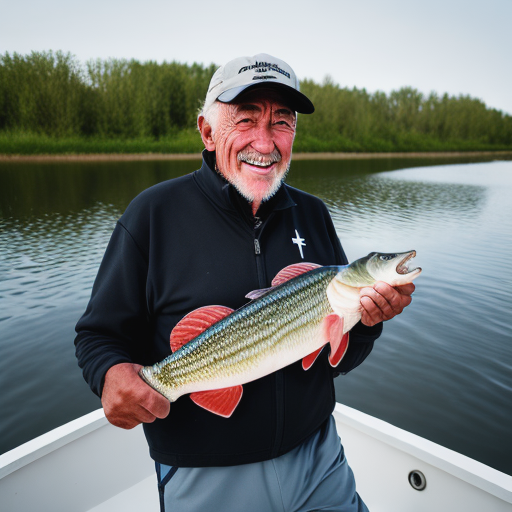Sea-run trout, including species like cutthroat and brown trout, are fascinating creatures known for their migratory behavior. They exhibit unique migration patterns as they navigate between freshwater and marine environments, showcasing anadromous trout migration. These migratory journeys provide valuable insights into their behavior and the factors that drive their movements.
To better understand the migration patterns of sea-run cutthroat trout in Willapa Bay, the Washington Department of Fish and Wildlife (WDFW) is conducting a comprehensive study. By tagging adult sea-run cutthroat trout with acoustic tags, researchers aim to track their movements from freshwater to marine water, unraveling the intricate trout migration behaviors. Through this study, they hope to identify the various routes taken by sea-run cutthroat trout in different habitats and determine the influence of environmental factors such as temperature, salinity, tides, and barriers on their migration patterns.
Key Takeaways:
- Sea-run trout, including cutthroat and brown trout, exhibit anadromous migratory behavior.
- The Washington Department of Fish and Wildlife is conducting a study to track and understand the migration patterns of sea-run cutthroat trout.
- Acoustic tags are used to track the movements of adult sea-run cutthroat trout from freshwater to marine environments.
- This study aims to identify different migration routes, analyze the influence of environmental factors, and enhance conservation efforts.
- Understanding sea-run trout migration patterns is crucial for their management and the conservation of their habitats.
Tracking Sea-Run Cutthroat Trout
The Washington Department of Fish and Wildlife (WDFW) is embarking on a groundbreaking study to track the movements of sea-run cutthroat trout. This initiative involves collaborating with anglers to release adult cutthroat trout with tracking tags in their bellies. By collecting data on the migratory behavior of these trout, the study aims to deepen our understanding of their movements in various habitats, including freshwater, estuarine, and nearshore marine environments.
An impressive fleet of approximately 200 adult sea-run cutthroat trout will be tagged and released in strategic locations across Washington and British Columbia. Anglers who catch a tagged trout are asked to report the tag to the WDFW, contributing to the collection of valuable data.
The tracking study will shed light on the intricacies of salmon trout migration and their behavior during fish spawning and migration. By examining the fine-scale movement of these trout in nearshore marine environments, fisheries experts hope to enhance fishing opportunities for recreational anglers.
Tracking trout migration is a crucial step towards preserving the populations of these incredible fish and ensuring the sustainability of their habitats. With the help of anglers, researchers, and fisheries managers, we can unlock the mysteries of sea-run cutthroat trout migration and protect their natural heritage for generations to come.
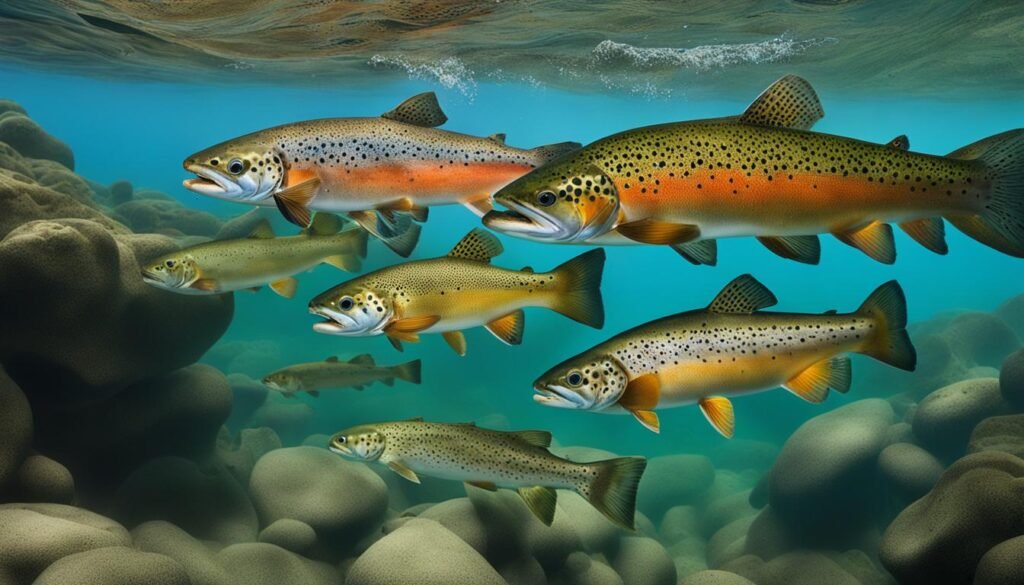
The Movement of Sea-Run Cutthroat Trout in Different Habitats
The study will focus on observing the sea-run cutthroat trout’s migration patterns and behavior in diverse habitats. These habitats include:
- Freshwater rivers and streams: Here, the trout begin their journey by actively seeking out optimal conditions for spawning.
- Estuaries and river mouths: These transitional areas play a vital role in the trout’s migration as they adjust to the changing salinity levels and adapt to new environments.
- Nearshore marine environments: In these nearshore waters, the trout navigate currents and locate suitable feeding grounds, ensuring their survival and growth.
An interactive view of the observed sea-run cutthroat trout migration patterns across these habitats is presented in the table below:
| Habitat | Migration Behavior | Key Environment Factors |
|---|---|---|
| Freshwater rivers and streams | Moving upstream for spawning | Favorable water flows, temperature, and depths |
| Estuaries and river mouths | Transitioning to changing salinity levels | Suitable conditions for acclimation |
| Nearshore marine environments | Locating feeding grounds and surviving | Optimal water temperature, food availability, and marine currents |
This comprehensive tracking effort will provide valuable insights into the behavior and movement of sea-run cutthroat trout across different habitats, furthering our understanding of their migratory patterns and influencing factors. With this knowledge, fisheries managers can take informed actions to ensure the conservation and sustainable management of these magnificent fish.
Migration Patterns of Sea Trout
A research study conducted on sea trout in Denmark revealed fascinating insights into their migratory patterns in a complex marine area with variable temperatures and salinities. The study utilized Hidden Markov Models (HMMs) to track the migration routes of sea trout based on temperature and depth records from electronic tags.
The findings of the study shed light on the behavior of sea trout during their migration. It was discovered that sea trout spent an average of 47-142 days at sea, with their movements predominantly concentrated near the coast. However, some remarkable individuals undertook long migrations, spanning up to an astonishing 580 kilometers away from their natal river.
The research also unveiled that sea trout exhibited different migration strategies based on the prevailing temperature and salinity conditions. These magnificent fish displayed an innate ability to seek out areas with optimal conditions for growth during different periods of the year.

Migration Patterns of Sea Trout
| Migratory Behavior | Migration Duration | Maximum Distance from Natal River |
|---|---|---|
| Coastal Migration | 47-142 days | – |
| Long-Distance Migration | – | Up to 580 km |
This research study highlights the remarkable adaptability and resilience of sea trout in response to their ever-changing marine environments. By deciphering their migratory patterns and understanding the factors that influence their movements, scientists and fisheries managers can develop effective strategies to conserve and manage the populations of these magnificent fish.
Movements of Brown Trout
Brown trout are highly adaptable fish that demonstrate remarkable survival skills across various environments. They exhibit migratory behavior, moving from oceans, reservoirs, and lakes into rivers for the purposes of spawning and feeding. During their stay in a river, the duration of which can range from two to three months up to half a year, brown trout engage in dynamic movements influenced by factors such as water levels, temperature, and food availability.
The migratory behaviors of brown trout are a vital subject of study, as they play a crucial role in the management and conservation of these fish. By understanding their movements, researchers and fisheries managers can make informed decisions that promote the long-term well-being of brown trout populations and ensure the preservation of their habitats.
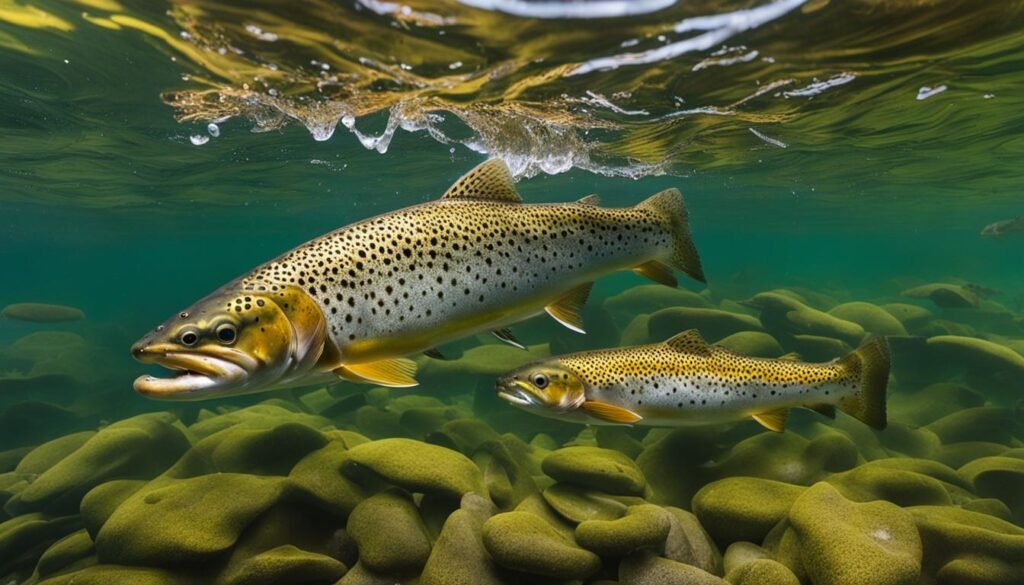
The movements of brown trout are influenced by a combination of environmental factors. For example, water levels affect their ability to migrate within a river or between different bodies of water. When water levels are too low or too high, brown trout may encounter obstacles that hinder their migration, such as shallow rapids or closed-off passages. In contrast, optimal water levels facilitate the smooth movement of brown trout and provide access to spawning and feeding grounds.
Temperature also plays a significant role in brown trout migration. As cold-water fish, brown trout thrive in cooler environments. They are more active and inclined to migrate when water temperatures are within their preferred range, typically between 50 and 60 degrees Fahrenheit (10-15 degrees Celsius). When temperatures exceed this range, brown trout may seek refuge in deeper, cooler sections of a river or other bodies of water.
Food availability is another crucial factor influencing the movements of brown trout. These fish migrate in search of abundant food sources, which are essential for their growth and survival. Brown trout are opportunistic feeders and consume a variety of prey, including insects, small fish, and crustaceans. When food sources become scarce in a particular location, brown trout will often migrate to areas where prey is more abundant, ensuring their nutritional needs are met.
Overall, studying the movements of brown trout provides valuable insights into their behavior and the factors that drive their migration. By understanding these patterns, researchers can develop effective strategies for managing brown trout populations and conserving their habitats for future generations.
Giant Trout Migration Strategies
Giant trout, particularly brown trout, exhibit unique migration strategies. These magnificent creatures have developed various tactics to navigate their surroundings and ensure their survival. When encountering stronger and larger fish, giant trout demonstrate their remarkable agility by evading potential threats. On the other hand, they actively seek out and consume weaker fish, showcasing their predatory nature and the skills that make them formidable predators.
Adaptability is one of the key traits that sets giant trout apart. They can thrive in diverse habitats, from fast-flowing rivers to deep lakes and even saltwater environments. These trout are constantly on the move, migrating in search of optimal conditions for feeding and spawning.
The migration strategies of giant trout are guided by their instinctual drive for survival. They possess an innate ability to sense changes in their environment and adapt accordingly. By constantly seeking out resources and suitable conditions, giant trout are able to maximize their chances of survival.
“The migration strategies of giant trout reflect their remarkable adaptation and cunning behavior. These trout are challenging to catch due to their elusive nature and their ability to outsmart even the most seasoned anglers.”
Despite the difficulties they present, giant trout have captivated the attention of anglers and fishing enthusiasts. Their size and cunning behavior make them highly prized targets for those seeking an exhilarating fishing experience.
Migration Strategies of Giant Trout:
- Evading encounters with stronger and larger fish
- Targeting and consuming weaker fish
- Migrating in search of optimal feeding and spawning conditions
- Thrive in diverse habitats, including rivers, lakes, and saltwater environments
- Constantly adapting to changes in their surroundings
Understanding the migration strategies of giant trout provides valuable insights into the behavior and survival mechanisms of these majestic fish. It allows us to appreciate their unique adaptations and enhances our ability to conserve and manage their populations for future generations to enjoy.
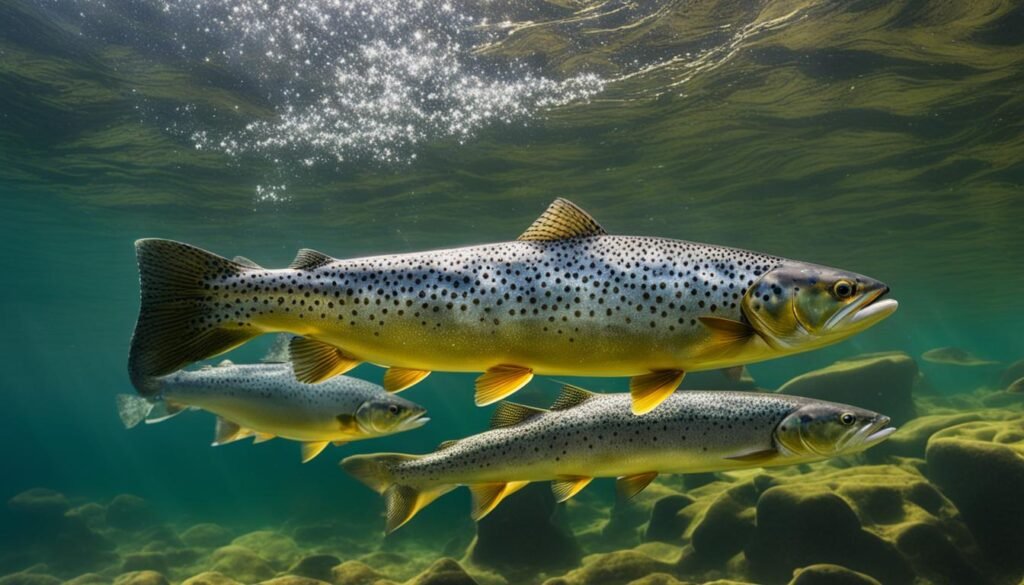
Migratory Behavior of Trout During Spawning
During the spawning season, trout exhibit specific migratory behavior. Female trout tend to be more passive, waiting in deep runs to drop their eggs on prepared gravel. Male trout, on the other hand, become more aggressive, fighting for the best spawning locations and defending against rival males. Trout that migrate into rivers in search of food can also display aggressive behavior, competing for prime feeding zones. Understanding the migratory behavior of trout during spawning is crucial for successful angling.
To exemplify the distinct migratory behavior of trout during spawning, let’s take a closer look at the various roles played by female and male trout.
Role of Female Trout During Spawning
Female trout exhibit a more passive behavior during spawning. They tend to gather in deep runs, patiently waiting for the ideal conditions to lay their eggs. These deep runs provide a secure and stable environment for the eggs to develop.
Once the female trout finds a suitable spot, she releases her eggs onto carefully prepared gravel, or a redd, that she has meticulously created by digging with her tail. The eggs then settle into the gravel, where they are protected from predators and provided with oxygenated water necessary for their development.
Role of Male Trout During Spawning
Male trout actively compete for the best spawning locations and engage in fierce territorial battles with rival males. The dominant males secure prime spots within the spawning grounds, where they can easily attract and mate with multiple females.
Male trout tend to display vibrant colors and develop hook-shaped jaws, known as kypes, during the spawning season. These physical changes reflect their increased aggression and fitness, enabling them to compete for mates effectively.
It is not uncommon for male trout to engage in confrontations, exhibiting aggressive behavior such as chasing and nipping at each other. They fiercely defend their territories from rival males in order to maximize their chances of successfully mating with multiple females.
Aggressive Behavior and Spawning Migration
Trout that migrate into rivers for feeding purposes may also display aggressive behavior. These trout compete for prime feeding zones where they can find an abundance of prey and optimal conditions for growth.
The migration patterns of trout during the spawning season are closely linked to their reproductive needs and the search for suitable habitats. Understanding these migratory behaviors is crucial for anglers, as it helps them identify the best fishing spots and techniques to increase their chances of success.
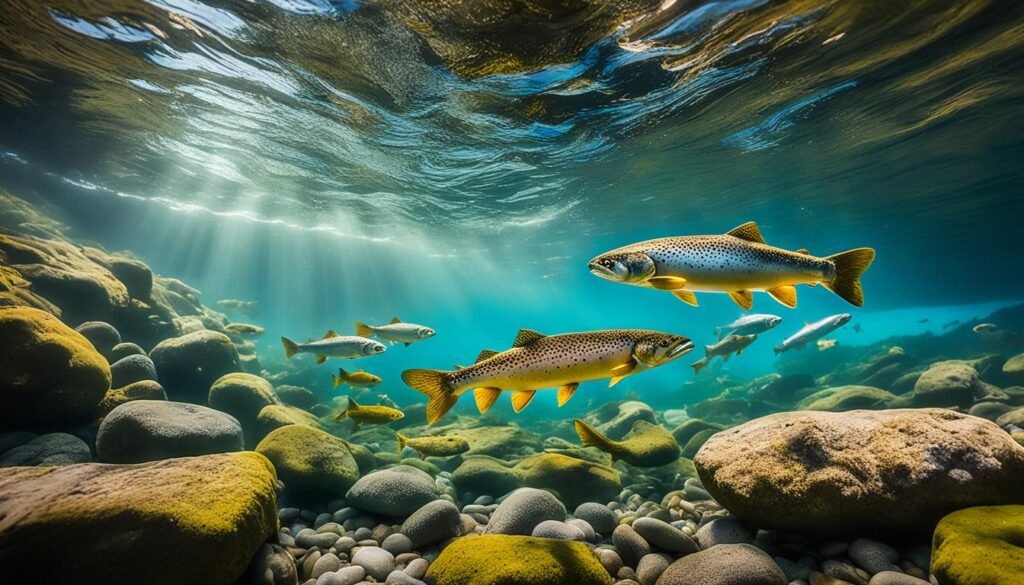
Habitat Selection and Migration of Sea Trout
Sea trout, specifically the subspecies known as seeforellen brown trout, exhibit complex migration and habitat selection behaviors. Depending on the region, sea trout may choose sedentary migration, staying within fjord and estuary systems, or use estuaries and fjords as short-term migration corridors to the sea. The unique habitat preferences and migration patterns of sea trout play a crucial role in their conservation and management.
One of the primary factors influencing the migration strategies of sea trout is the abundance of predator and prey species in their habitat. Sea trout are known to select areas with optimum food availability and suitable refuge from potential predators during their migration. These habitat preferences ensure their survival and successful completion of their migration journey.
Temperature and salinity also significantly impact the migration of sea trout. These fish are sensitive to changes in water temperature and salinity levels, and they tend to migrate towards areas with optimal conditions for their physiological needs. By selecting habitats that provide the right temperature range and salinity, sea trout can ensure their survival and reproductive success.
“The migration strategies of sea trout vary depending on the region, with sedentary migration and short-term migration corridors being common patterns.”
Understanding the habitat preferences and migration patterns of sea trout is vital for their conservation and management. It allows fisheries managers and conservationists to identify critical habitats and implement measures to protect these areas. By preserving the habitats that sea trout rely on, we can ensure the long-term viability of their populations and maintain healthy and sustainable ecosystems.
Habitat Preferences of Sea Trout
| Habitat Factor | Preference |
|---|---|
| Food availability | Optimal prey abundance |
| Predator presence | Suitable refuge areas |
| Temperature | Optimal range for physiological needs |
| Salinity | Appropriate levels for survival and reproduction |

Behavior of Resident and Migratory Trout
When it comes to trout behavior, there are distinct differences between resident and migratory trout. Let’s take a closer look at their unique characteristics:
Resident Trout Behavior
Resident trout are well acquainted with their habitat. They have spent their entire lives in the river and are familiar with its nooks and crannies. To avoid predators, resident trout have specific hiding spots where they feel secure.
Another advantage that resident trout possess is their coloration and markings, which help them blend seamlessly into their environment. This natural camouflage enables them to go unnoticed by both predators and prey.
Migratory Trout Behavior
In contrast, migratory trout, like the iconic brown trout, undertake long journeys from different aquatic environments such as oceans, large lakes, or deep reservoirs to the river where they will spawn. This migration exposes them to new surroundings and challenges.
Migratory trout are more light-averse due to their unfamiliarity with river habitats. They seek cover in areas with distorted surfaces or prefer darkness to ensure their safety. This behavior helps them avoid potential predators and increases their chances of survival.
Additionally, migratory trout may display aggressive behavior when defending their feeding zones or competing for mates. These territorial encounters can be intense as trout battle for limited resources within the river.
Habitat Selection and Migration
The unique behaviors of both resident and migratory trout demonstrate their adaptability to different environments and the specific challenges they face. Understanding these behaviors is crucial for effective trout conservation and management.

By studying their behavior, researchers can gain valuable insights into the preferences and needs of resident and migratory trout. This knowledge aids in developing sustainable management strategies that preserve their populations and protect their habitats.
Timing and Environmental Factors in Migration
Trout migration is influenced by various timing and environmental factors. Understanding these factors is crucial for predicting and comprehending the patterns of trout migration.
Stream Flows
Trout wait for suitable stream flows before initiating their upstream migration for spawning. Changes in water levels can significantly impact their movement. High water levels facilitate easy passage upstream, providing the necessary conditions for trout to navigate obstacles and reach their spawning grounds.
Water Temperatures
Temperature is another key environmental factor that influences trout migration. As water temperatures rise, migratory trout are prompted to begin their journey. Warmer temperatures can trigger the movement of trout, signaling that the conditions are favorable for their migration and spawning activities.
Monitoring and Prediction
In order to better understand and predict trout migration patterns, it is essential to monitor these environmental factors. Collecting data on stream flows and water temperatures can help researchers and fisheries managers gain insights into the timing and behavior of migratory trout populations.
“Timing and environmental factors play a significant role in trout migration.”
By studying the relationship between these factors and the timing of trout migration, researchers can enhance their understanding of these behaviors and develop effective conservation and management strategies.

| Timing Factors | Environmental Factors | Impact on Trout Migration |
|---|---|---|
| Stream flows | Water levels | Facilitate or hinder upstream passage |
| Water temperatures | Temperature changes | Prompt or delay migratory movement |
Conclusion
Studying the migration patterns of sea-run trout, such as cutthroat and brown trout, provides valuable insights into their behavior and the factors that drive their movements. Understanding fish movement and migration is essential for fisheries managers and researchers to make informed decisions regarding the conservation and management of these species.
Tracking the movements of migratory fish enables us to gather data on their habitat preferences, migration routes, and behavior, helping us better protect their populations. By monitoring their movements, scientists can identify critical areas, such as spawning grounds and migration corridors, and implement measures to preserve these habitats.
Through this research, we can gain a deeper understanding of the environmental factors that influence trout migration, including water levels, temperature, salinity, and the availability of food. This knowledge is crucial for predicting and managing the timing of trout migration, ensuring their safe passage during spawning, and protecting their habitats throughout their life cycles.
By comprehending the migratory patterns and behaviors of sea-run trout, we can work towards preserving healthy populations and ensuring the sustainability of their habitats. This knowledge not only benefits the trout themselves but also contributes to the overall health and balance of freshwater and marine ecosystems.
FAQ
What are the migration patterns of sea-run trout?
Sea-run trout, such as cutthroat and brown trout, exhibit various migration patterns. Some may migrate within their natal fjord or estuary, while others travel long distances to different habitats. Factors such as temperature, salinity, tides, and barriers can influence their migration.
How are sea-run cutthroat trout tracked?
The Washington Department of Fish and Wildlife (WDFW) is conducting a study to track the movements of sea-run cutthroat trout. The trout are tagged with acoustic tags in their bellies, which allow researchers to monitor their movements from freshwater to marine water. Anglers are asked to release any tagged sea-run cutthroat trout they catch and report the tags to the WDFW.
What did the study on sea trout migration in Denmark reveal?
The study in Denmark used electronic tags and Hidden Markov Models to track the migration routes of sea trout. It found that sea trout migrated at sea for varying durations and mostly stayed close to the coast. However, some individuals migrated up to 580 km away from their natal river. Their migration strategies were influenced by temperature and salinity conditions.
How do brown trout migrate?
Brown trout exhibit migratory behavior, moving between oceans, reservoirs, lakes, and rivers for spawning and feeding. The duration of their stay in a river can vary, depending on factors such as water levels, temperature, and food availability.
What are the migration strategies of giant trout?
Giant trout, especially brown trout, have unique migration strategies. They migrate in search of suitable feeding and spawning conditions. They are highly adaptable, elusive, and can survive in various habitats. They tend to evade stronger and larger fish while attacking and consuming weaker fish.
How do trout behave during spawning?
During spawning, female trout typically wait in deep runs to drop their eggs on prepared gravel. Male trout become more aggressive, fighting for the best spawning locations and defending against rival males. Trout that migrate into rivers for feeding can also display aggressive behavior when competing for prime feeding zones.
What are the habitat preferences and migration patterns of sea trout?
Sea trout, specifically seeforellen brown trout, exhibit complex migration and habitat selection behaviors. They may choose sedentary migration within fjord and estuary systems or use estuaries and fjords as short-term migration corridors to the sea. Factors such as predator/prey abundances, temperature, and salinity influence their migration strategies.
How do resident and migratory trout differ in behavior?
Resident trout are familiar with their habitat and have specific hiding spots to avoid predators, blending into their environment. Migratory trout, like brown trout, come from different environments and are more light-averse, seeking cover in distorted surfaces or darkness. Migratory trout may also exhibit aggressive behavior when defending feeding zones or competing for mates.
What factors influence trout migration timing?
Timing and environmental factors play a significant role in trout migration. Trout wait for suitable conditions, such as stream flows and water temperatures, before migrating upstream for spawning. Changes in water levels and temperature can trigger their migration. High water levels facilitate easy passage upstream, while warmer temperatures can prompt the movement of migratory trout.
Why is it important to understand fish movement and migration?
Understanding the movement and migration patterns of fish, including sea-run trout, is crucial for their conservation and management. Tracking their behavior helps researchers and fisheries managers make informed decisions to preserve healthy populations and ensure the sustainability of their habitats.

